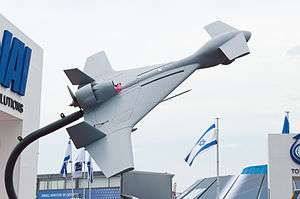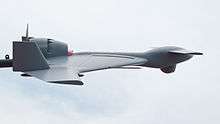IAI Harop
The IAI Harop (or IAI Harpy 2) is a loitering munition developed by the MBT division of Israel Aerospace Industries. It is an anti-radiation drone that can autonomously home in on radio emissions. Rather than holding a separate high-explosive warhead, the drone itself is the main munition. This SEAD-optimised loitering munition is designed to loiter the battlefield and attack targets by self-destructing into them.[1] The drone can either operate fully autonomously, using its anti-radar homing system, or it can take a human-in-the-loop mode. If a target is not engaged, the drone will return and land itself back at base.
| Harop | |
|---|---|
 | |
| IAI Harop at Paris Air Show 2013 | |
| Role | Loitering munition |
| National origin | Israel |
| Manufacturer | Israel Aerospace Industries |
| Developed from | IAI Harpy |
It has been designed to minimize its radar-signature through stealth (low-observability). This anti-radiation drone is designed to target enemy air-defense systems in a first line of attack, as the small drone (with its small radar cross-section) can evade SAMs and radar detection systems which are designed to target much larger aircraft or to intercept fixed-trajectory missiles.[2]
Overview
The IAI Harop has a loiter (flying) time of 6 hours and a range of 1000 km both ways. It is a larger version of the IAI Harpy and is launched from ground- or sea-based canisters, but can be adapted for air-launch.[1] The Harop can either operate fully autonomously, or it can take a man-in-the-loop mode, being controlled by a remote operator.[3] The Harop features two guidance modes: it can either home in on radio emissions by itself with its anti-radar homing system,[4] or the operator can select static or moving targets detected by the aircraft's electro-optical sensor.[1] This latter mode allows the Harop to attack radars that are presently shut down and therefore not providing emissions for the aircraft to automatically home in on.[4] If a target is not engaged, the drone will return and land itself back at base. The small drone (with a Radar Cross Section similar to a large bird) can evade SAMs and radar detection systems which are designed to target much larger aircraft or to intercept fixed-trajectory missiles.

IAI is developing a smaller version of the Harop for smaller applications, which it will unveil in 2015. The smaller Harop would be one-fifth the size and have a lighter 3–4 kg (6.6–8.8 lb) warhead. It will be cheaper and have a shorter endurance of 2–3 hours to be used tactically against time-critical targets or ones that hide and re-appear.[5]
History
Turkey may have been the launch customer for the Harop in 2005.[4] In October 2005, MBDA submitted the Harop (under the name "White Hawk") to the United Kingdom's Ministry of Defence for consideration as the system for the Ministry's Loitering Munition Capability Demonstration (LMCD) program, otherwise known as "Fire Shadow".[6][7] The Harop was selected as one of the finalists, but was rejected when the MoD decided that the contract should go to a British team.[6]
In August 2007, the government of India was negotiating to purchase eight to ten Harop systems.[3] In September 2009, the Indian Air Force announced that it will be inducting the Harop systems purchased for US$100 Million.[8] The Harop was publicly unveiled to the world for the first time in India, in the lead-up to the Aero India 2009 show.[6] In February 2019, the Indian Air Force decided to add another 54 Harop drones to its fleet of around 110 of these drones, which they had renamed P-4.[9]
In April 2018, IAI systems were observed in a film made by the Azerbaijan Army, specifically the IAI Harop loitering munition system, resulting in criticism from the Armenian government concerning the supply of Israeli arms to the Azeri army.[10]
Combat history
It first used in combat by Azerbaijan in the Nagorno-Karabakh conflict in April 2016.[11][12] IAI Harop drones operated by Azerbaijan were used to destroy buses full of Armenian soldiers being transported to the frontline.[13] The loitering drones were also reportedly used to destroy an Armenian command post.
The Harop was also credited for destroying a Syrian Air Defence SA-22 Pantsir on 10th May 2018.[14]
Specifications
Data from "Israel special - IAI's Harop ups the stakes on SEAD missions"
General characteristics
- Crew: None
- Length: 2.5 m (8 ft 2 in)
- Wingspan: 3.00 m (9 ft 10 in)
Performance
- Range: 1000 km ( miles)
- Endurance: 6 hours 0 min
Armament
- 23 kg warhead
References
- "Israel special - IAI's Harop ups the stakes on SEAD missions"
- Israeli-made kamikaze drone spotted in Nagorno-Karabakh conflict Archived 2017-10-10 at the Wayback Machine By Thomas Gibbons-Neff April 5, Washington Post
- "India eyes IAI's Harop attack UAV"
- Sweetman 2009
- IAI developing smaller tactical Harop loitering munition Archived 2016-03-06 at the Wayback Machine - Flightglobal.com, 28 October 2014
- "Israel Unveils Loitering Anti-Missile Drone"
- "Rivals unveil concepts for loitering munition demo"
- "IAF plans to induct Harop UCAV by 2011". The Times Of India. 2009-09-30. Archived from the original on 2019-02-15. Retrieved 2009-09-30.
- Indian Air Force buys another 54 Israeli HAROP drones Archived 2019-02-14 at the Wayback Machine, DebkaFile, Feb 13, 2019.
- Kubovich, Yaniv. "Advanced Israeli Weapons Sold to Azerbaijan Exposed in Army-produced Pop Music Video". Haaretz.com. Retrieved 14 December 2019.
- "Arminfo: Azerbaijan uses Israel-made Harop drone against NKR". arminfo.am. Archived from the original on 8 April 2016. Retrieved 6 April 2016.
- "Archived copy". Archived from the original on 2018-01-30. Retrieved 2018-04-04.CS1 maint: archived copy as title (link)
- "Azerbaijan Used IAI's Harop UCAV". Archived from the original on 2016-07-14. Retrieved 2017-04-01.
- "Archived copy". Archived from the original on 2018-05-14. Retrieved 2018-05-14.CS1 maint: archived copy as title (link)
- Անօդաչու սարքի անկումը Մարտակերտում. 4 April 2016. Archived from the original on 6 April 2016. Retrieved 6 April 2016 – via YouTube.
- Martin Streetly, ed. (2014). Jane's All the World's Aircraft: Unmanned 2014-2015. London: IHS Jane's. p. 101. ISBN 978-0710630964.
- "Indian air force orders Harop loitering munitions". Flightglobal.com. Archived from the original on 9 May 2016. Retrieved 6 April 2016.
External links
| Wikimedia Commons has media related to IAI Harop. |
- "India eyes IAI's Harop attack UAV". Jane's Defence Weekly. 28 August 2007.
- "Israel special - IAI's Harop ups the stakes on SEAD missions". Flight International. 11 February 2008. Retrieved 2009-02-20.
- "Israel Unveils Loitering Anti-Missile Drone". Defense Update. Archived from the original on 2018-03-15. Retrieved 2009-02-20.
- "Rivals unveil concepts for loitering munition demo". Flight International. 20 September 2005. Retrieved 2009-02-20.
- Sweetman, Bill (11 February 2009). "IAI Predicts Big UAV Market - And Unveils Loitering Missile". Ares: A Defense Technology Blog. Retrieved 2009-02-20.
- New IDF UAV revealed (video) (in Hebrew)